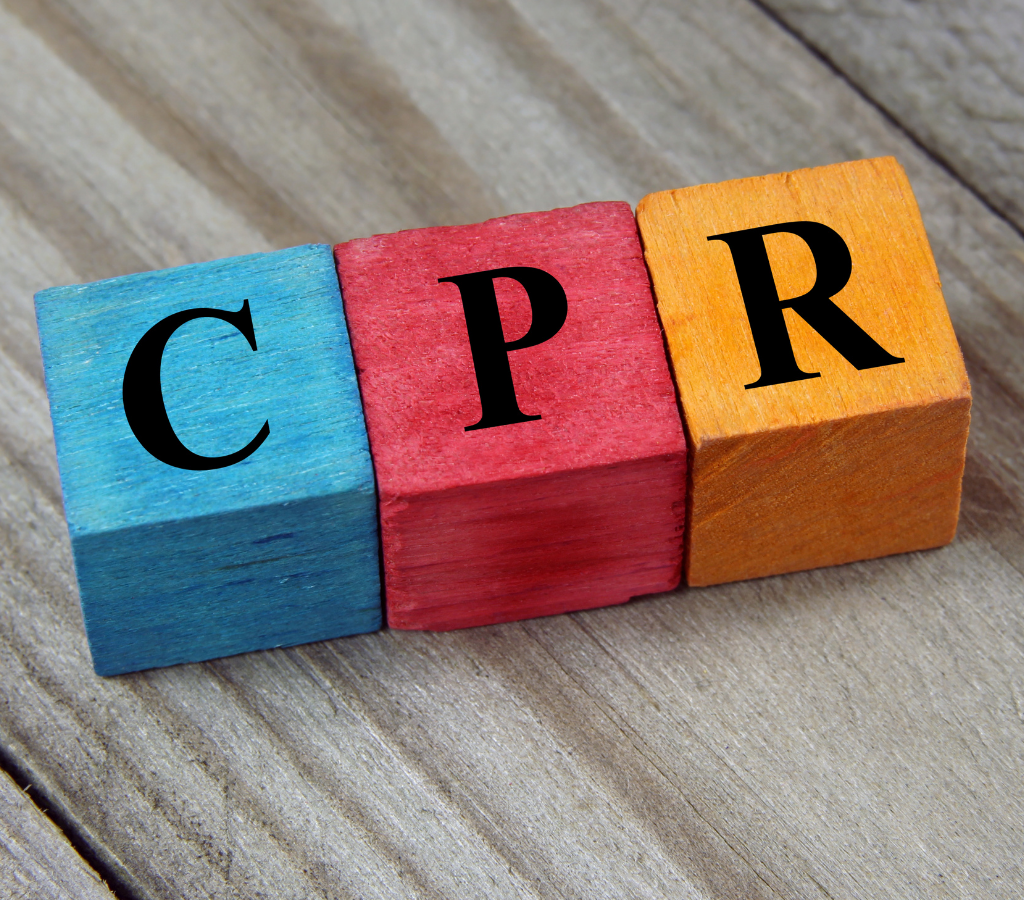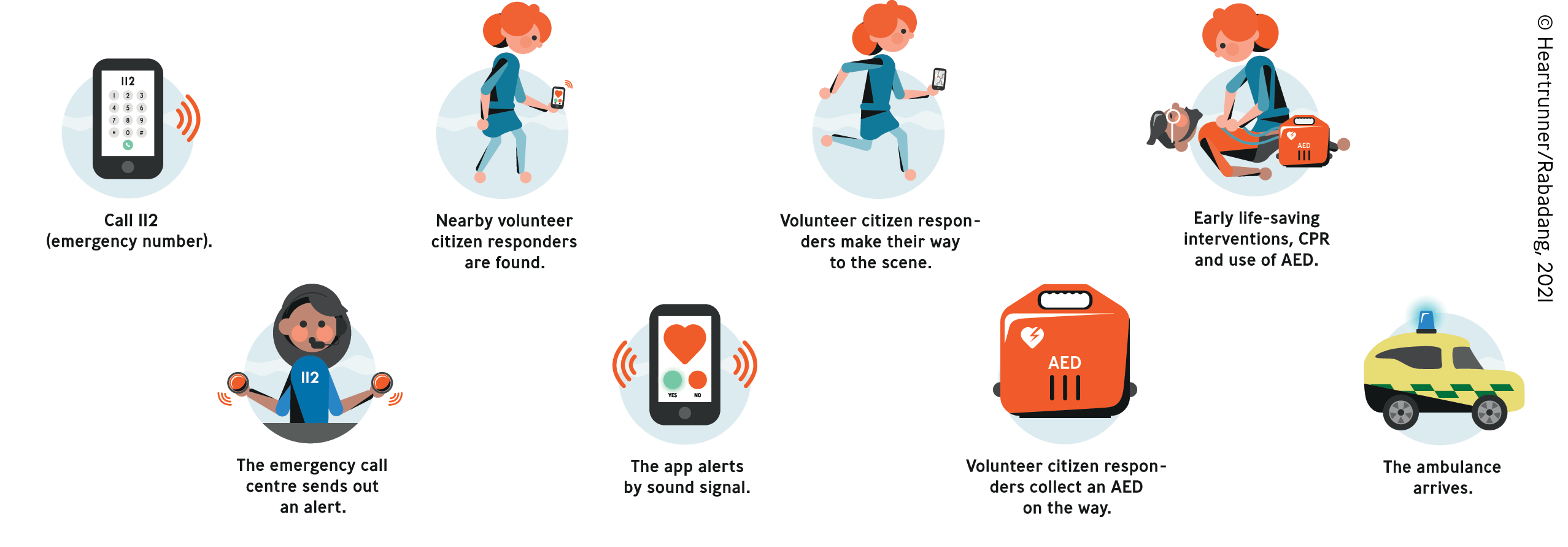Europe, we have a problem!
- Categories: Defibrillators, On-scene operations, On-scene technology
So, what´s the problem?
In the UEFA 2020 match between Denmark and Finland, we witnessed Christian Eriksen collapse on the field. Almost immediately, medical staff started CPR and quickly an AED was used. After some chilling minutes, he was carried off the field and later we learned that Eriksen watched the final minutes of the match from his hospital bed at Rigshospitalet in Copenhagen.
All this unfolded live and made it clear to a slightly new audience that early CPR and AED use saves lives. OHCA has been in the headlines and we have seen a surge for CPR training like never before.
Let´s assume that you are trained in CPR, how would you know that on the third floor of your office building, in the nearby park or in your neighbour’s kitchen, someone is suffering an OHCA right now?

I got my first CPR training in the late 1980s as a scout, and frequently re-trained throughout military service, high school, university and in my job as a nurse in Sweden. I’ve done CPR on a fair number of patients suffering from cardiac arrest in my profession, but I never encountered an OHCA patient. Not until 2013 when I was alerted through a citizen responder system launched a few years earlier in Stockholm. I responded quickly and rushed to a neighbour’s apartment and performed CPR for 5-6 minutes until the ambulance arrived.
I met his wife some weeks later and she told me he survived and occasionally I still see them in the local store. It took over 20 years of frequent CPR training until I got to use my skills to save someone’s life outside my profession. Many unnecessary deaths could be prevented if more got the chance to do the same. The Swedish initiative started off as a scientific project and in a randomised controlled trial, bystander CPR rates increased by over 30% when a citizen responder was first on the scene.[2]
There are hundreds of thousands of well-trained potential lifesavers in Europe, living their lives without ever getting the chance to make a difference. But it’s rare that you just pass someone collapsing from OHCA and most OHCA (approximately 75%) occur in the victim’s home. [1]
European CPR guidelines advocate volunteer actions
In the recently published guidelines for CPR from the European Resuscitation Council (ERC), a full section (#3) is dedicated to “Systems Saving Lives”. The ERC states that technology should be used to engage communities and recommends the implementation of systems alerting volunteers to OHCA through smartphone apps/text messages. A common name used for these volunteers is citizen responders.
Denmark leads the way
In 2020, Denmark became the first European country to implement a nationwide system for alerting citizen responders. Now volunteers can provide help to OHCA victims no matter where in Denmark they are. Currently over 105,000 citizen responders have registered, and they save lives. In a recently published study from Copenhagen, researchers reports that OHCA victims defibrillated by public AEDs prior to the arrival of an ambulance tripled when volunteers were first on the scene – from 7% to 21%. [3]
How a system like this works
A system alerting citizen responders enhances the radius of perception for someone with CPR skills. The purpose is to engage motivated CPR-trained citizens. First to download an app, register and then if they are nearby an OHCA, alert them to reach the victim before the ambulance, to start CPR and use an AED.
This strengthens the chain of survival, and it all starts with a 112 call and the dispatch centre alerts the ambulance. At the same time, they also alert nearby citizen responders, who quickly make it to the scene, possibly well before the ambulance, and start CPR. In an OHCA, every minute counts and survival could be doubled or even tripled if CPR starts, and an AED is used within the first 3–5 minutes after collapse. [4]
In a publication by Deakin et.al (2018), an alternative illustration of the “chain of survival” was presented. It showed that of all patients in OHCA, where someone called 112, only 48% received CPR before the ambulance arrived, and only 12 % were treated by an AED.[5] This exemplifies the importance of engaging volunteer citizen responders. If a motivated, CPR skilled volunteer nearby could be alerted in the event of OHCA, it’s likely that the survival rate could be increased. And we need to keep as many patients as possible in each link in the chain of survival through bystander CPR and AED use.

In the epidemiology section of the ERC 2021 CPR guidelines, they refer to the EuReCa TWO study and state the rate of bystander CPR in Europe at 58% on average, with a range from 13–83%.[6] It’s not enough, and even though dispatcher-assisted CPR is a thing, many times the 112 caller is an elderly spouse perhaps incapable of performing effective CPR. This is another example where educated and motivated citizen responders can make a great difference! Why not give people a chance to help their fellow citizens and put their CPR skills to use to save more lives?
An effective citizen responder system should include data from a national (or regional) AED registry, be possible to connect to any dispatch system in Europe, and I would advocate for the possibility to manage statistics of alerts to manage national or regional follow up of outcome, as well as for research purposes. This makes it possible to measure and improve, and to evaluate efficacy as well as support research projects, perhaps on a pan-European level.

What about the citizen responders?
There is a trend – people want to help each other, more people are engaged in society, and showing heart. We’ve seen it during the Covid-19 pandemic: neighbours shopping for groceries for the elderly, and so on. But what happens when a stranger knocks on the door of a private home to give CPR? Experiences from Denmark and Sweden say these issues are not a problem, no adverse events have been reported in the 10+ years of alerting citizen responders in Sweden. A recent dissertation from the Karolinska Institutet also shows that citizen responders feel good after helping OHCA victims – they show higher wellbeing than individuals not alerted through the citizen responder programme.[7]
Why should your country or region implement a citizen responder system?
First of all, science shows it’s important and that it works. Secondly, the new guidelines for CPR from the ERC recommend the introduction of citizen responder systems in all European countries. And lastly, it saves lives, and money for society, and it gives the citizen responders a strong feeling of solidarity and contribution to society.
We can’t save every victim of OHCA, but we should give them a fair chance of survival. Introducing a system that saves lives in your country gives you the best possible opportunity to do so. And hopefully we will be able to see more lives saved just like Christian Eriksen´s, through quick intervention from motivated and educated responders, not only on a football field.
We’ll be exploring this topic in more detail in an EENA document to be released in September on Citizen Response to Out of Hospital Cardiac Arrest. You’ll be able to find detailed recommendations and guidelines on implementing a system alerting citizen responders. Stay tuned!
[1] Grasner, J. et al., (2016). EuReCa ONE-27 Nations, ONE Europe, ONE Registry: A prospective one month analysis of out-of-hospital cardiac arrest outcomes in 27 countries in Europe. Available from: https://pubmed.ncbi.nlm.nih.gov/27321577/
[2] Ringh M. et al., (2015) Mobile-Phone Dispatch of Laypersons for CPR in Out-of-Hospital Cardiac Arrest. Available from: https://www.nejm.org/doi/full/10.1056/NEJMoa1406038
[3] Andelius, L. et al., (2020) Smartphone Activation of Citizen Responders to Facilitate Defibrillation in Out-of-Hospital Cardiac Arrest. Available from: https://www.jacc.org/doi/full/10.1016/j.jacc.2020.04.073
[4] Valenzuela, T. et al., (1997). Estimating effectiveness of cardiac arrest interventions: a logistic regression survival model. Available from: https://pubmed.ncbi.nlm.nih.gov/9396421/ and Holmberg, M. et al., (2004). Effect of bystander cardiopulmonary resuscitation in out-of-hospital cardiac arrest patients in Sweden. Available from: https://pubmed.ncbi.nlm.nih.gov/11004382/ and Perkins, G. et al., (2015). Part 3: Adult Basic Life Support and Automated External Defibrillation: 2015 International Consensus on Cardiopulmonary Resuscitation and Emergency Cardiovascular Care Science With Treatment Recommendations. Available from: https://pubmed.ncbi.nlm.nih.gov/26472859/
[5] Deakin C.D., (2018). The chain of survival: Not all links are equal. Resuscitation. Available from: https://pubmed.ncbi.nlm.nih.gov/29471008/
[6] European Resuscitation Council. Guidelines 2021: Systems saving lives, Available from: https://cprguidelines.eu/assets/guidelines/RESUS-8901-SSL.pdf
[7] Berglund, E., (2020). Dispatch of Lay Responders to Out-Of-Hospital Cardiac Arrest. Karolinska Institutet. Available from: https://openarchive.ki.se/xmlui/bitstream/handle/10616/47448/Thesis_Ellinor_Berglund.pdf?sequence=3&isAllowed=y
Additional resources:
An interesting read in the Washington Post: https://www.washingtonpost.com/health/an-app-that-swiftly-sends-cpr-volunteers-to-heart-attack-sufferers-has-made-a-big-differences-in-denmark-could-this-be-copied-in-the-us/2021/05/07/97c59cc6-8734-11eb-8a8b-5cf82c3dffe4_story.html
ILCOR/COSTR. First Responder Engaged by Technology Systematic Review. Available from: https://costr.ilcor.org/document/first-responder-engaged-by-technology-systematic-review
European Resuscitation Council, (2020). Enhancing citizens response to out-of-hospital cardiac arrest: A systematic review of mobile-phone systems to alert citizens as first responders. Available from: https://www.sciencedirect.com/science/article/abs/pii/S0300957220301854
Smartphone-based dispatch of community first responders to out-of-hospital cardiac arrest – statements from an international consensus conference – https://sjtrem.biomedcentral.com/articles/10.1186/s13049-021-00841-1
The opinions expressed are those of the author and do not necessarily represent the views of EENA. Articles do not represent an endorsement by EENA of any organisation.
Share this blog post on:
